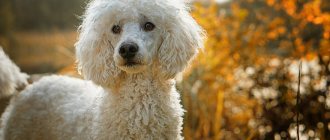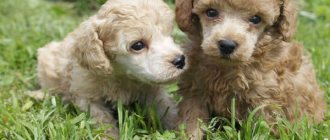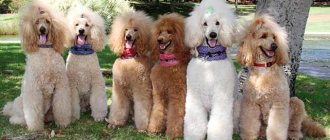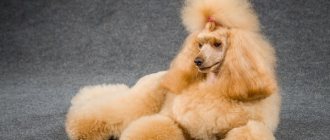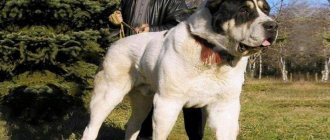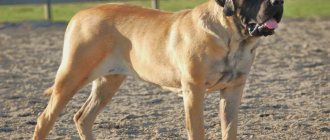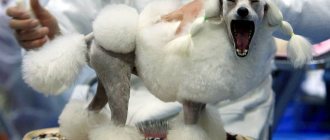- Pets
- >>
- Dog breeds
* Here is a photo of a typical representative of the Toy Poodle dog breed . You can send us photos of your animals by email, and we will post them on the website. Don't forget to send your pet's name.
Other breed names:
Miniature Poodle, Miniature Poodle
Video
* We invite you to watch a video about the Toy Poodle . In fact, in front of you is a playlist in which you can select and watch any of 20 videos about a given dog breed by simply clicking on the button in the upper right corner of the window. In addition, the material contains quite a lot of photos. By looking at them you can find out what a Toy Poodle looks like.
In this article:
|
Rate the material!
[Total votes: 3 Average: 3.7]
The Toy Poodle is an elegant and pretty dog, famous for its miniature size, unusual curly hair, good-natured and cheerful character, and intelligence. It looks exactly like the Royal Poodle, but is tiny in stature. This breed perfectly combines the appearance and proportions of its older brother.
Photo of a toy poodle
Toy does not know resentment, vindictiveness and aggression. He loves the family in which he lives; He is characterized by some shyness and sensitivity, especially to harsh voices or sounds. The breed prefers the company of people rather than dogs or other animals. She lacks watchdog qualities, although she is wary of strangers. But unlike its guard brother, it will not bark or growl at a stranger, but will run away from him.
The pros and cons of a toy dog attract the attention of many dog breeders. His virtues are balance, calmness, and a natural tendency to obedience. Representatives can even be quiet and shy, so they will not start barking for no reason. The breed is excellent for apartment living and can tolerate loneliness for a long time.
The history of the origin of the toy poodle
Dog handlers are completely convinced that the poodle is one of the most ancient dog breeds. Several centuries ago, such dogs were ubiquitous in most countries in Western Europe. As for the homeland of the poodle, at different times different countries claimed this title - France, Hungary, Germany, and their ancestors are considered to be shepherd or water dogs with shaggy and curly hair.
All the same dog experts are sure that the poodle owes its appearance to several dog breeds at once. Thus, according to etymological analysis and written documents, the ancestors of poodles are called bullets, water spaniels, barbets, Hungarian shepherds, retrievers, greyhounds and pointers.
Interesting fact: The first written mentions of poodles can be found in European chronicles that date back to the 16th century. Several varieties of these dogs are also mentioned here, which differ from each other in color and size. The Toy Poodle (miniature poodle) is one of them.
Toy poodles gained the greatest popularity in the 18th century and fans of the breed, as a rule, were representatives of the European nobility. Around the same time, the art of hairdressing began to develop rapidly in Europe, and during the reign of Louis XVI, the first hairdressing salons for animals already appeared in Paris.
The court hairdressers also tried to keep up with fashion and began to cut their masters' pets in a variety of styles. The king himself, in order to please his beloved wife Marie Antoinette, issued a decree proclaiming the miniature poodle a court breed.
The Toy Poodle is bred from the Royal Poodle. Moreover, the first one belongs to the decorative breeds, and the second one to the service and sporting breeds. The toy poodle received official status as a decorative dog breed only in 1936, and the latest breed standard dates back to 2007.
Video: toy poodle
Trimming is an essential aspect of not only caring for your pet. It is thanks to the haircut that the poodle is recognizable at first sight as a breed; it is prescribed by the standard. If a dog performs at exhibitions, trimming is a must. For example, there are the following types of haircuts:
- “Lion” means shaving the hair on the muzzle, hind legs from the beginning of the hock joint, one third of the tail, hips, groin and rump, and forearms. Thick fur remains only on the neck, forming a “collar”, like a lion’s.
- “Like a sheep” - the covering on the throat, belly, muzzle is shaved; on the paws and third of the tail.
- “Pappy Clip” – the soles, tail and muzzle get rid of fur. The rest of the fur is cut so that it is the same size along the entire length.
- “Anglo-Saxon” is an analogue of the “lion” haircut. The difference between this type of trimming is that in the area of the groin, lower back and croup the hair is not completely cut off, but 1–2 cm is left.
Toy poodle - description of the breed
The prefix “toy” in the name of the toy poodle means “toy” in English. That is, toy poodle literally means “toy poodle.” Representatives of this breed in appearance correspond to the appearance characteristics of the Royal Poodle, with the exception of their small size.
At the same time, minor deviations in the dog’s appearance from the standard are not a significant reason for culling, but the show score may be reduced. Toy poodles with pronounced defects are not allowed to show and are not recommended for breeding.
The height and weight of an adult individual directly depends on its category, of which breeders distinguish two: toy and small toy. Toy - height at withers no more than 28 cm, and weight - 3-5 kg. Small toy - height at the withers up to 25 cm, and weight - up to 2 kg.
The toy poodle has a regular shaped, fox-type head. The forehead is of medium width, convex and somewhat oblong. A toy poodle's nose is proportional to its head. The color of the nose is black or matches the color of the coat. The eyes are almond-shaped, with dense and colored eyelids. The color of the iris ranges from amber or golden to dark brown.
The ears are hanging type, rectangular and rounded at the ends, adjacent to the head. The poodle's physique is proportional, regular, with smoothed withers and a pronounced scruff. The back is of medium width and tapers somewhat at the croup. The croup itself is round, the stomach is tucked, and the lower back is well defined.
The tail is straight and set high. According to the standard, both natural and docked tail lengths are allowed. The dog's paws are smooth, dense with fairly strong joints, proportional to the length of the body with pads and claws that match the base color or the color of the nose. Hips are wide and muscular.
Main characteristics
| Breed parameters | |
| Country of origin: | Germany |
| Weight of the breed: | 3–5 kg |
| Height at withers: | 28 cm |
| Temperament: | calm |
| Wool: | middle length |
| Role in human life: | companion |
| Breed group: | decorative |
The Toy Poodle, like its relatives - the Royal, Medium and Dwarf - is recognized by its aristocratic haircut. The owner needs to spend a lot of time and attention on caring for the pet, especially its fur. The dog is hypoallergenic, almost does not shed, and is ideal for an owner with allergies.
Popular colors of toy poodles
The coat of the toy poodle is curly, thick, with fine guard hairs. The hairs themselves are quite elastic and resist being compressed. There are also individuals with coarser corded fur. There is no undercoat, and there is no dog smell either. Toy poodles do not actively shed and their fur does not cause allergies.
The Toy Poodle comes in a wide variety of colors. Only six options have been officially approved (according to the standard), but in reality there are many more. After all, when crossing dogs with different coat colors, the color of the offspring can turn out to be the most unpredictable. Yes, such dogs will not be allowed to show, but in all other respects they will be quite decorative and cute.
Dogs of the Toy Poodle breed have the following colors:
- White. The most common and popular color today. The toy poodle with white fur looks very noble. Puppies may have a faint cream or apricot tint to their coat, which fades over time. The skin of a white dog is usually pink, less often spotted. The nose and claws are black, the eyes are brown;
- Black. Classic color. In this case, the color of the coat should be extremely even, without spots of other colors or a reddish tint. Paw pads, claws, nose - only black, without any multi-colored spots. Skin - gray or blue;
- Brown (chocolate). The coat has a uniform, rich brown color without spots. The fur on the ears is a little lighter. The nose is brown, the eyes are amber or brown;
- Silver. The coat is an even silver-gray color. It is interesting that this color is formed only by 2-3 years of a dog’s life, because puppies are born with black hair. However, according to some signs, dog lovers can identify silver color starting from six weeks. At the same time, the eyelids, nose, lips are black, and the eyes are dark brown, almost black;
- Red (mahogany). Coat color is dark red. Nose, eyelids, lips - brown or black;
- Apricot. All apricot shades are allowed - from dark to light. As a dog ages, its coat becomes lighter in color. Very old dogs have a cream colored coat. Skin color is pink, much less often blue. The color of the eyelids, nose and lips is black or brown.
In 2007, two more colors were added to the Toy Poodle breed standard - white and black (harlequin) and black with tan (markings) of any color.
Story
There are different opinions about the appearance of the Toy Poodle breed. Most breed researchers are confident that micro dogs were bred in France.
But some consider their homeland to be Germany, since the word “poodle” - pudelhaas - is of German origin. Translated, it sounds like “throughly wet.” This reflects the original purpose of the pets, which delivered killed game from the water to hunters.
The second part of the name “toy” comes from the English Toy (toy). Indicates that the dog belongs to the smallest variety of poodles. According to the description, pets are below 28 cm at the withers.
Clubs for breeding shaggy mini dogs appeared in the 19th century. The original breed standards were developed in England. Their publication dates back to 1886. At the same time, poodles began to appear in Russia, where the breed quickly gained recognition. Dogs become pets and are valued among the intelligentsia. The official breed standard, authored by French breeders, was developed and adopted in 1936.
Character and habits of toy poodles
All varieties of poodles are distinguished by their quick wit and fairly high intelligence. Such dogs learn very easily and with interest, and also master complex tricks with great pleasure. If an animal lives in a family, then it very quickly remembers the most frequently used phrases of the people around it and over time begins to understand everything that is said to it.
Toy poodles are active and cheerful dogs. They become very attached to their owners and require constant attention; they do not tolerate loneliness quite well, which is why it is better not to leave them alone in the apartment for a long time. If your toy poodle is left alone at home all day, you should definitely get a second pet (cat or dog).
Toy poodles are very willing to play with children, but the behavior of the latter should be delicate and not cause any unpleasant sensations to the animal. When children impose their company too much on a dog, it can show its hunting nature and even bite. For this reason, adults should clearly explain to the child that a pet is not a toy, but a family member whose feelings and desires must be respected.
The toy poodle is always friendly and tolerant towards other pets. The dog can readily communicate with both small and large dogs, as well as cats. The Toy Poodle is very friendly to strangers and will willingly play with unfamiliar house guests if they so desire. The dog is completely indifferent to ordinary passers-by on the street.
Due to its intelligence and intellectual development, this breed is able to quickly learn not only the simplest commands, but also more complex ones. Dog experts recommend training a puppy in a playful way, and a separate lesson should not last more than 15 minutes. Another piece of advice from dog trainers: repetition is the mother of learning. Therefore, you need to repeat the lessons constantly - even several times a day.
Negative sides
But these dogs also have disadvantages, which include:
- Toy poodles are too friendly towards strangers . This makes them poor guards, and there is a risk that strangers might steal the dog or harm it.
- Shyness. Toy poodles can be afraid of loud noises or large dogs, which creates certain difficulties when walking with them.
- The behavior of these dogs is sometimes difficult to predict , especially if the dog is not trained.
- Like many indoor dogs, toy poodles are not averse to barking over trifles .
- These dogs can easily get injured by jumping off high furniture.
- They need special maintenance : regular haircuts, expensive food, a variety of clothes suitable for different weather conditions.
- There is a slightly greater predisposition to diseases than in larger breed varieties of poodles, which is why such a pet must always be under the supervision of a veterinarian.
Important! Toy poodles need more frequent walking than larger dogs: you need to walk them at least 3 times a day.
Interesting facts about toy poodles
The toy poodle is a thinking dog, and such an unusual quality for a pet should be developed and encouraged in every possible way. To do this, the owner needs to communicate a lot with the dog, constantly explain and comment on his actions.
If you don’t raise your toy poodle at all, then there will be nothing good in it. After all, an ill-mannered dog who has no concept of subordination will most likely consider himself the main member of the family and will demonstrate his disobedience in every possible way.
The owner of a toy poodle should think carefully before taking the pet into his bed, because even after the first time it will not be possible to wean the dog from sleeping together.
Reliable facts about the origin of these dogs have not been found, however, as a result of an investigation, canine specialist from Switzerland Rosa Engler expressed a reasonable assumption that the homeland of miniature poodles is Central Asia, or more precisely, Phenicia.
Initially, toy poodles were called differently. At first the breed was called “barbet”, then “mini-poodle”, and in the twentieth century the modern name took root. Excellent memory and a keen sense of smell, inherited from hunting dogs, help the toy poodle to accurately find his way home, even if he gets lost and runs far enough.
Toy poodles are the longest-living dog breed. Their average life expectancy is 15-18 years.
These dogs eat very little, which is a definite plus. However, they are very desperate beggars. After all, in order to get a tasty treat, the toy poodle will dance, fulfill all commands, and look pleadingly into the owner’s eyes.
The Toy Poodle is a very social dog. Growing up in a family, a pet literally becomes humanized, beginning to take a direct part in all household and family affairs.
Video “How to trim a toy poodle”
In this video, a specialist will show you how to properly cut a miniature poodle's haircut.
Similar article: History of the origin of the breed and description of the poodle
Recommended Posts
Standard height and weight of the Cane Corso breed by month
Weight of a puppy and an adult Labrador by month
Weight and height of a German Shepherd puppy by month
38 best dog breeds for apartments according to reviews from breeders and owners
Description and content of the hunting border terrier
Review of the 12 most unpretentious and obedient dog breeds
Pros and cons of toy poodles
Many owners and dog handlers consider many of their qualities to be the indisputable advantages of toy poodles. Moreover, such a list can be quite long.
Advantages of a toy poodle:
- Very high intelligence;
- Lively mind;
- Hypoallergenic;
- Sociability;
- Tolerance towards children;
- Friendliness and tolerance towards other pets;
- Ease of education and training;
- Lack of active molting.
As for the shortcomings of the breed, opinions are different and quite contradictory, because they are not at all associated with the negative behavior of the animal, but are rather based on the purely personal impressions of different people.
Disadvantages of the Toy Poodle:
- Strong attachment to the owner;
- Mobility (need for frequent long walks and active games);
- Some difficulties in caring for the coat (expensive cosmetics, regular haircuts, etc.).
A considerable part of the owners of these cute dogs are of the erroneous opinion that they do not need training and education at all. Dog handlers are sure that they are wrong, because while walking down the street, an animal, for example, can pick up and eat something wrong, or get carried away by its dog affairs, run away and not immediately return to its owner. Also, a complete lack of education usually leads to various problems when visiting a veterinarian or when traveling.
When training and raising a toy poodle, its owner must understand that the nervous system of this dog is quite sensitive, so using harsh methods or, worse, physical punishment is completely unacceptable. Also, for every well-performed action, a diligent pet must be rewarded with a treat.
Description and breed standard
Toy poodle mini dogs, despite the young age of the breed, have already successfully passed the standardization procedure at the international and regional level. Therefore, there is a specific characteristic of the breed. To meet the standards, a Toy Poodle must have the following description:
- The typical size for an adult is 24–28 cm. The ideal height is 25 cm, and the weight is no more than 3 kg. The dwarf subspecies is slightly larger. However, the canine service does not separate these two varieties;
- an elongated head that resembles a fox's muzzle;
- dark, large nose;
- almond-shaped dark eyes. Sometimes there are amber inclusions. They are planted narrowly;
- ears strongly widened at the base. At the ends they are rounded and hang. The ears are completely covered with curly hair. Can stop at an early age;
- solid color and any color;
- the body is folded proportionally;
- The paws are strong and muscular.
As you can see, the standard includes various criteria that a purebred dog of this breed must meet. If the standard is not met according to all criteria, the animal is considered defective. Therefore, if you plan to breed these animals at a high level, you need to know a detailed description of the breed.
Related article: How to choose a healthy poodle puppy and name it beautifully
Breeding Toy Poodles
Toy poodles reach puberty quite early. Females become ready to breed at 7-8 months, and males at 12-18 months. Since already at this time dogs begin to strive for copulation, they need to be closely monitored and protected from unwanted mating, especially for females.
It is also worth knowing that it is unreasonable to start breeding precisely at the onset of puberty, because the animals must still get stronger physically. Thus, it is quite logical to allow females to breed from 18 months, and males from 24 months.
As for the female’s sexual cycle, this event occurs twice during the year with a frequency of 6 months. Accordingly, each sexual cycle ends with estrus. At this time, the female’s external genitalia and mammary glands enlarge and bloody discharge appears, the smell of which serves to convey information about the female’s readiness for mating. It is important for the owner of a female to know that the smell of estrus spreads over long distances, attracting males from all over the area, so you need to keep an eye on her at this time.
Important fact: Toy poodles are usually mated from the 9th to the 14th day of estrus. It is clear that only very healthy animals that have been previously examined by a veterinarian are allowed to breed.
There are two ways of knitting: hand and freestyle. The manual method is usually used when mating a young, restless female with a more experienced male. They put a muzzle on the female, hold her by the collar and belly, and also encourage her in every possible way.
When freestyle mating, the bitch and dog are left alone for some time. Typically, this method is used with more experienced females and with a clear interest in the opposite sex on their part.
Mating is usually carried out in the morning, after a preliminary walk and before feeding. It is impossible to separate animals during the act of mating. The second mating (control) is carried out under the same conditions a couple of days after the first.
Origin story
This breed appeared not so long ago, during the period of fashion for hunting dogs. The mini poodle cannot be called an aggressive protector or hunter, since its main task was to serve as a kind of page. This dog could catch killed game from the water and present it to its owner. There are many varieties of this breed. All of them have received international recognition, including the toy poodle.
Loading …
Caring for Toy Poodles
The most suitable conditions for keeping a miniature poodle are a city apartment. Although this does not mean at all that such a pet will feel bad in a country house, but rather quite the opposite. After all, the opportunity to walk freely will only improve the dog’s physical fitness and general health.
When keeping an apartment, the fact that a toy poodle can be taught to use a litter box does not mean at all that you won’t have to walk him outside for a long time. Regardless of this, you will have to take the dog for walks, because in addition to correcting its natural needs, the animal requires movement, a lot of movement. So, you need to walk your toy poodle every day, two to three times a day, and the walk should not be less than an hour long.
To ensure that your miniature pet always looks neat and well-groomed, regular grooming of its fur is actually vital. You need to brush your dog daily, at least every other day. To do this, you need special devices: a massage brush and a comb.
The toy poodle loves water, so you can bathe your dog often (1-2 times a month) and this process will not cause him any inconvenience. As a detergent, you should use a special shampoo for dogs with long hair. It is clear that in addition to brushing and bathing, the toy poodle will need regular haircuts.
Also, once a week your pet will need the following procedures:
- Examination of the mouth and teeth for damage;
- Nail trimming;
- Examination of eyes and ears.
If damage, purulent discharge or other unpleasant symptoms appear, you should immediately contact a veterinarian. Also, from the first day of life, a toy poodle should have its own things in the house: dishes, a bed, toys, overalls for walks in cold weather.
Breed description, standards and appearance
The Toy Poodle is the smallest representative of the breed. He is smart, active, harmoniously complex.
Adult dog sizes:
The ideal height at which dogs are rated as high as possible is 25 cm at the withers. Toy poodles less than 24 cm at the withers are disqualified.
The dimensions of the animal must correspond to the following proportions:
- the length of the muzzle is less than the length of the skull in the ratio of 9 to 10;
- rectangular body;
- the croup is almost at the level of the withers;
- The distance from the withers to the elbows is 4/9 of the height.
For your information. On the Internet, the breed is often called the “dwarf toy poodle.” This is fundamentally wrong. Toy poodles and toy poodles are different groups of dogs that differ in size.
Description of the breed (ICF standard No. 172):
The nature of the toy poodle's movements is light and springy. The dog should not run too smoothly or stretched out. From the outside it seems as if the dog is not making any effort.
Important. Toy poodles with an aggressive or cowardly nature, as well as dogs with obvious anomalies in physical structure or behavior, are subject to disqualification.
Diet of Toy Poodles
A miniature poodle can be fed either commercially prepared food or natural food. Moreover, in the case of a natural menu, meat products in the diet should be at least a third. Preference should be given to beef, and fresh, rather than frozen, beef or chicken liver. Some meat can be boiled, but raw meat must also be present on the menu.
It is better to use water as a base for porridges rather than meat broth. The following porridges can be cooked: rice, millet, buckwheat, oatmeal. You can occasionally treat your pet to pasta, but under no circumstances overfeed this product. Eggs (chicken, quail), as well as cottage cheese, can be given to a toy poodle no more than twice a week. If your pet refuses cottage cheese, you can offer him cheesecakes, of course, they must be dietary (the bare minimum of fat and sugar).
Important fact: Periodically add raw and boiled vegetables (carrots, zucchini, pumpkin, cauliflower, broccoli, beets) and some fruits (apples, pears) to your pet’s diet.
As for dry food, you need to buy it in special stores. Needless to say, it’s not worth saving on food for your pet, because this will directly affect his well-being and if his health deteriorates, treatment will cost many times more. If your pet is prone to allergies, then he will need hypoallergenic food.
In addition to food, it is important for a toy poodle to maintain fluid balance in the body, so his drinking bowl should always have fresh, clean, boiled water, which should be changed twice a day (morning and evening). Adult dogs (from 8 months) are given two meals a day, six-month-old puppies - three meals a day, two-to-five-month-old puppies - four meals a day.
Care and maintenance of a toy poodle
Toy poodles are valued for their compact size. They feel great in small apartments. When following the recommended hygiene procedures, pets remain active for a long time.
The dog’s luxurious coat requires the main attention. She is brushed daily, even with short hair. Dogs are given baths on average every 7 weeks. After returning from the street, be sure to wash the pet’s paws and wipe the dog’s body to remove any minor dirt with a damp cloth.
The care and maintenance of a poodle includes regular updating of the show hairstyle. To do this, go to a specialized salon once every 2 months.
In cold seasons, the dog is given clothing for walking, which will help prevent the dog from becoming hypothermic. In heavy rain or frost outside, a toilet-trained pet remains at home.
Among the hygiene procedures for a poodle, brushing of teeth (daily) and ears (once a week) is practiced. The dog's nails are trimmed if they have time to grow back within a month's interval. The pet's eyes are examined and wiped regularly.
Diseases and health problems
Small breed dogs often get sick. The Toy Poodle is considered a relatively healthy breed, but is still susceptible to some diseases.
The most common diseases of toy poodles:
- A congenital defect of the fusion of the nasal passages, in which the animal experiences severe snoring and difficulty breathing. It can only be treated with surgery;
- Heart diseases. To reduce the risk of disease, it is important not to physically overload your pet and protect it from stress;
- Eye diseases. Most often, such dogs have cataracts, conjunctivitis, retinal atrophy, glaucoma, and entropion. Most eye diseases are passed on to offspring genetically and have almost no cure. Older dogs often begin to see poorly or become completely blind;
- Epilepsy. Another hereditary disease that is diagnosed at a tender age and is associated with increased excitability of the animal. Epilepsy can either progress during the animal’s life or be in remission;
- Diabetes. The endocrine system, in particular the pancreas, is the weakest point of all small dog breeds. Diabetes is not directly inherited, but genetic predisposition plays a role;
- Oral diseases. Toy poodles, especially with age, suffer from stomatitis and gingivitis. The cause of the disease is insufficient oral care and poor nutrition;
- Otitis. The direct reason here is the shape of the ears, which does not allow them to be fully ventilated. If fluid gets inside a dog's ear, it can easily develop inflammation. An important preventive measure against otitis media is proper and timely ear hygiene;
- ICD (urolithiasis). It manifests itself as a result of a serious metabolic disorder, which is caused by the accumulation of salts in the body and their improper elimination, thereby provoking the appearance of stones in the bladder and kidneys.
Also, small dog breeds suffer greatly from various viruses. Therefore, strict adherence to the vaccination schedule is very important for them.
Varieties
The breed is not officially divided into varieties. However, in Japan, small dogs were bred, 22–24 cm tall and weighing up to 3 kg, which were called the “Japanese toy poodle”. They are a genetic mutation and are considered defective.
The Japanese Toy Poodle cannot participate in exhibitions or breeding. Tiny dogs require even more careful care because they have weak skeletons and are prone to a whole bunch of diseases.
However, the Japanese Toy Poodle has the same friendly and positive personality. Following fashion trends, people keep him as a pet, despite possible problems.
Color and coat type
The Toy Poodle's body is covered with elastic and well-pigmented skin. In white dogs it is silver in color, in animals of all other colors it corresponds to the color.
Representatives of the breed can have two types of fur:
The spine should be fine in structure, and the coat should be thick and fluffy. Sparse, flabby, hard fur is a serious drawback.
Allowed colors:
Important. Toy poodles with white markings in colored coats are disqualified.
In 2008, the RKF recognized two more colors - harlequin (black and white) and black and tan. Now such dogs are considered separate breeds: harlequin and phantom. They are not yet recognized by the FCI, but they are successfully bred in the USA, Germany, Austria, and the Czech Republic.

